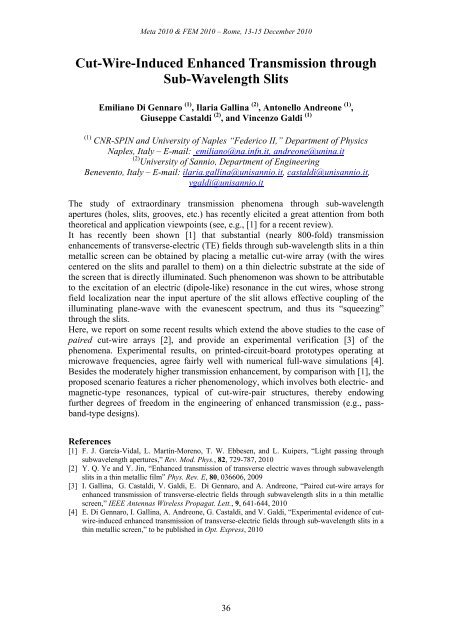Abstracts - Dipartimento di Elettronica Applicata
Abstracts - Dipartimento di Elettronica Applicata
Abstracts - Dipartimento di Elettronica Applicata
You also want an ePaper? Increase the reach of your titles
YUMPU automatically turns print PDFs into web optimized ePapers that Google loves.
Meta 2010 & FEM 2010 – Rome, 13-15 December 2010<br />
Cut-Wire-Induced Enhanced Transmission through<br />
Sub-Wavelength Slits<br />
Emiliano Di Gennaro (1) , Ilaria Gallina (2) , Antonello Andreone (1) ,<br />
Giuseppe Castal<strong>di</strong> (2) , and Vincenzo Gal<strong>di</strong> (1)<br />
(1) CNR-SPIN and University of Naples “Federico II,” Department of Physics<br />
Naples, Italy – E-mail: emiliano@na.infn.it, andreone@unina.it<br />
(2) University of Sannio, Department of Engineering<br />
Benevento, Italy – E-mail: ilaria.gallina@unisannio.it, castal<strong>di</strong>@unisannio.it,<br />
vgal<strong>di</strong>@unisannio.it<br />
The study of extraor<strong>di</strong>nary transmission phenomena through sub-wavelength<br />
apertures (holes, slits, grooves, etc.) has recently elicited a great attention from both<br />
theoretical and application viewpoints (see, e.g., [1] for a recent review).<br />
It has recently been shown [1] that substantial (nearly 800-fold) transmission<br />
enhancements of transverse-electric (TE) fields through sub-wavelength slits in a thin<br />
metallic screen can be obtained by placing a metallic cut-wire array (with the wires<br />
centered on the slits and parallel to them) on a thin <strong>di</strong>electric substrate at the side of<br />
the screen that is <strong>di</strong>rectly illuminated. Such phenomenon was shown to be attributable<br />
to the excitation of an electric (<strong>di</strong>pole-like) resonance in the cut wires, whose strong<br />
field localization near the input aperture of the slit allows effective coupling of the<br />
illuminating plane-wave with the evanescent spectrum, and thus its “squeezing”<br />
through the slits.<br />
Here, we report on some recent results which extend the above stu<strong>di</strong>es to the case of<br />
paired cut-wire arrays [2], and provide an experimental verification [3] of the<br />
phenomena. Experimental results, on printed-circuit-board prototypes operating at<br />
microwave frequencies, agree fairly well with numerical full-wave simulations [4].<br />
Besides the moderately higher transmission enhancement, by comparison with [1], the<br />
proposed scenario features a richer phenomenology, which involves both electric- and<br />
magnetic-type resonances, typical of cut-wire-pair structures, thereby endowing<br />
further degrees of freedom in the engineering of enhanced transmission (e.g., passband-type<br />
designs).<br />
References<br />
[1] F. J. García-Vidal, L. Martín-Moreno, T. W. Ebbesen, and L. Kuipers, “Light passing through<br />
subwavelength apertures,” Rev. Mod. Phys., 82, 729-787, 2010<br />
[2] Y. Q. Ye and Y. Jin, “Enhanced transmission of transverse electric waves through subwavelength<br />
slits in a thin metallic film” Phys. Rev. E, 80, 036606, 2009<br />
[3] I. Gallina, G. Castal<strong>di</strong>, V. Gal<strong>di</strong>, E. Di Gennaro, and A. Andreone, “Paired cut-wire arrays for<br />
enhanced transmission of transverse-electric fields through subwavelength slits in a thin metallic<br />
screen,” IEEE Antennas Wireless Propagat. Lett., 9, 641-644, 2010<br />
[4] E. Di Gennaro, I. Gallina, A. Andreone, G. Castal<strong>di</strong>, and V. Gal<strong>di</strong>, “Experimental evidence of cutwire-induced<br />
enhanced transmission of transverse-electric fields through sub-wavelength slits in a<br />
thin metallic screen,” to be published in Opt. Express, 2010<br />
36








